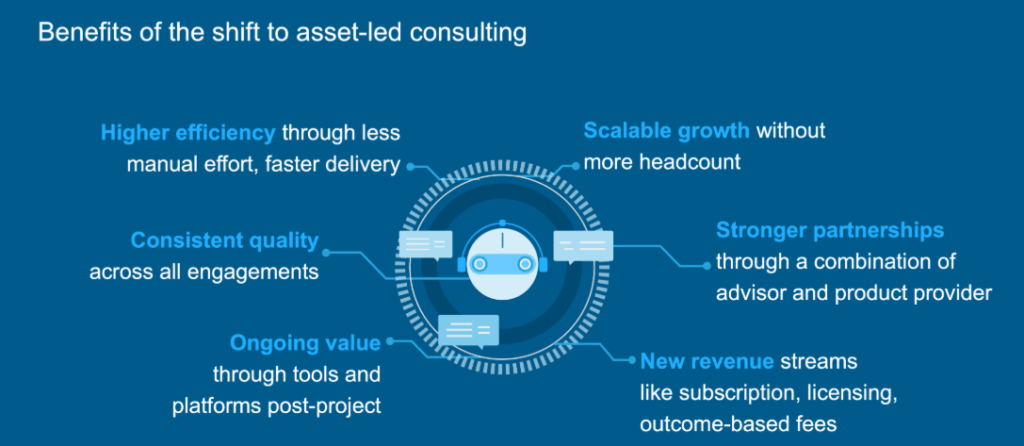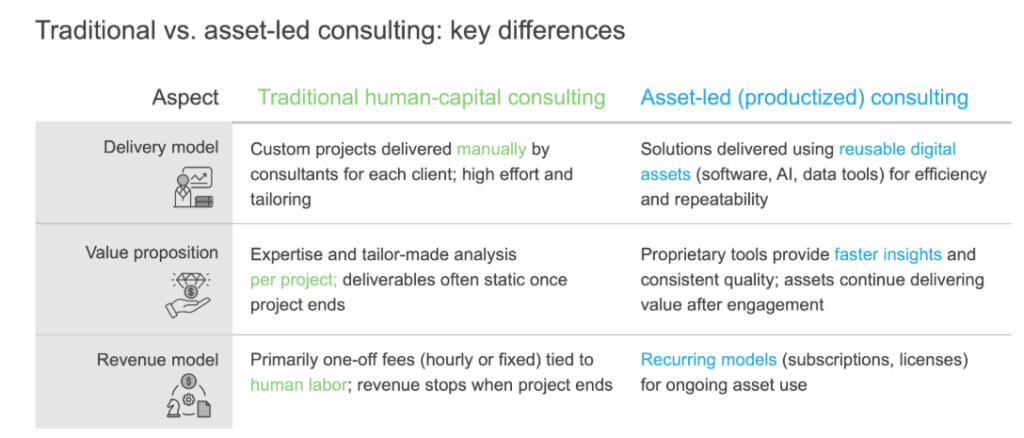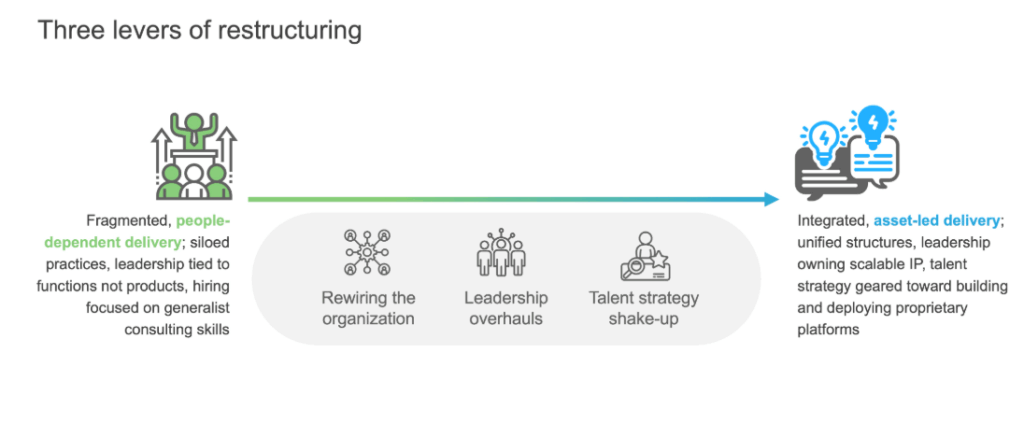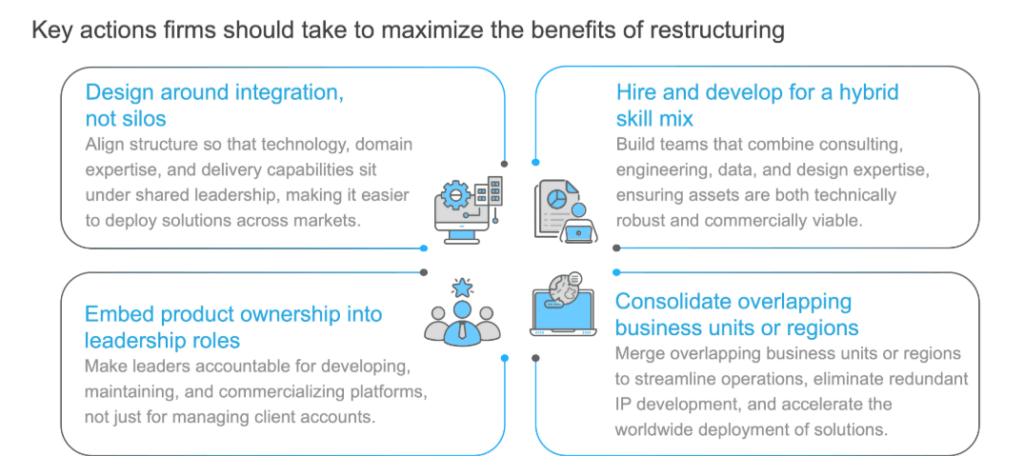Beyond the Billable Hour: Why Consulting Firms are Restructuring for an Asset-led Future

Consulting firms across the board are embarking on significant internal restructuring efforts. The immediate driver is operational efficiency, streamlining processes, cutting costs, and breaking down long-entrenched silos to create a more unified, agile organization.
For example, Deloitte in 2024 undertook an overhaul, consolidating five business units into four to reduce complexity and free up resources. Economic headwinds made such moves prudent, but beyond cost-cutting and operational efficiencies lies a strategic pivot: firms are reorganizing to support new long-term visions and offerings.
Reach out to discuss this topic in depth.
As historic patterns note, companies often reorganize to align structure with new strategic goals, such as pivoting to new product lines or entering new markets. For consulting firms, that new product line is increasingly the productized, asset-led service, packaged tools and platforms that complement (or even replace) traditional human-delivered advice.
Restructuring is thus seen as building a future-ready structure, breaking down siloed departments and talent misalignment to foster greater collaboration and innovation. In short, firms aren’t just tightening belts they are rewiring themselves for a new consulting paradigm.
This structural reset is not just about how consulting firms are organized either; it’s about fundamentally changing what they deliver and how they create value. The consulting model is shifting away from a reliance on people-intensive, bespoke engagements, and moving toward a new paradigm where scalable tools, platforms, and repeatable solutions sit at the heart of delivery.
From human capital to asset-led consulting
The consulting industry is shifting from selling hours to delivering value through proprietary tools, technology, and intellectual property (IP). In asset-led consulting, firms deploy pre-built assets such as software, Artificial Intelligence (AI) models, and data platforms to solve client problems faster and more consistently, avoiding the need to reinvent the wheel each time.
This shift brings a range of benefits for both firms and clients, transforming how work is delivered, how relationships are built, and how value is captured.


As the table shows, this shift reshapes a consulting firm’s DNA, redefining how work gets done, how value is created, and how revenue flows. Such a fundamental change cannot happen on the surface; it demands a deep internal overhaul. The next sections unpack three critical ways firms are restructuring to unlock and scale asset-led consulting.

-
- Rewiring the organization: From siloed practices to agile structures
To pivot successfully, consulting firms are overhauling their organizational structures. Historically, large firms were segmented into discrete practices, think strategy vs. operations vs. tech or separated by industry and geography.
These silos often meant each group developed its own tools and approaches, with limited cross-pollination. Today, the emphasis is on integration and agility. Firms are rewiring themselves into flatter, cross-functional structures that can rapidly assemble the right mix of skills (consulting, engineering, data, etc.) around an asset or client problem. This often means merging or realigning old divisions.
Some examples include:
-
- As part of EY’s “All in” strategy, the firm has unified its Strategy and Transactions service line under the EYParthenon brand, bringing together 25,000 professionals across 150 countries. This expansion is underpinned by a US$250 million investment in AI-powered Edge platforms, including Competitive Edge, Diligence Edge, and Capital Edge, designed to scale Mergers & Acquisition (M&A), corporate finance, and transformation globally and cohesively.
-
- Accenture announced that it will consolidate its five core business units, Strategy, Consulting, Song, Technology, and Operations into a single entity, Reinvention Services, effective September 1, 2025. Led by Chief Services Officer Manish Sharma, the reorganization aims to accelerate AI integration across the firm and deliver faster, more cohesive solutions at scale.
Restructuring for agility means operating as “One Firm”. Silos slow innovation, while asset-led consulting thrives on blending domain, tech, and data expertise. By reorganizing, firms foster cross-domain collaboration through interdisciplinary product teams or innovation hubs, creating an integrated setup that can quickly mobilize the right skills without bureaucratic barriers.
-
- Leadership overhauls: New alignments for new priorities
Such deep structural changes go hand-in-hand with leadership overhauls. Consulting firms are rethinking who leads and how. With asset-led consulting rising, firms need leaders who not only manage client relationships but also own and scale products and platforms. This has prompted new leadership roles and alignments focused on technology, innovation, and integration.
Some examples include:
-
- PwC’s US arm announced a major leadership reshuffle in mid-2024 to become more client-centric, tech-powered and agile. As part of this, they established a new Operating Committee and appointed a Chief Information Officer to drive technology enablement across the firm.
-
- EY strengthened its leadership in technology and data by appointing Joe Depa as Global Chief Innovation Officer to scale innovation and digital capabilities worldwide, Richard Clough as Global Chief Data Officer to lead data strategy and digital transformation, and Eoin O’Reilly as Head of AI & Data for EY Ireland to drive AI and data adoption in the region.
These leadership changes signal a broader shift in how consulting firms are preparing for the future. AI-focused appointments are not just about adopting new technologies, they represent a commitment to embedding data, digital tools, and scalable solutions at the core of delivery.
By placing seasoned leaders in charge of these capabilities, firms are ensuring that innovation is driven from the top, reinforcing the connection between strategic direction, technology adoption, and the development of repeatable solutions that enhance both speed and quality of client outcomes.
-
- The talent strategy shake-up: Hiring for the future, not the past
A shift to asset-led consulting also demands a new approach to talent. The ideal consulting workforce of the future looks very different from the traditional army of MBAs and industry generalists. Firms are hiring for the future, bringing in software engineers, data scientists, User experience (UX) designers, product managers, and other specialists to build and maintain the technology assets at the core of modern consulting. Many consulting firms have started shifting to skills-based hiring and recruiting candidates with in-demand digital skills, rather than just the usual business degrees.
Some examples include:
-
- Bain’s Engine 2 Ventures, for instance, explicitly recruits for roles in product, engineering, data science, customer success, and more roles that mirror a tech startup environment rather than a classic consultancy.
-
- Capgemini plans to hire 40,000 to 45,000 staff in India in 2025, with 35 to 40% being lateral hires, demonstrating a strong emphasis on experienced talent, particularly those with AI and digital transformation skills.
The talent model is shifting from relying on a uniform pool of generalists to building teams that combine deep technical expertise, industry knowledge, and consulting skills. Tomorrow the consulting workforce will be a multidisciplinary mix, where specialists and advisors collaborate seamlessly to deliver innovative, high-impact solutions.
The new consulting playbook: Restructuring for a hybrid model of people and products
The consulting industry is undergoing one of its most significant transformations in decades. Restructuring is no longer just a way to streamline operations; it’s the foundational step toward building a hybrid delivery model that blends human expertise with scalable products and platforms.
The shift to integrated structures, new leadership alignments, and future-focused talent strategies is enabling firms to move beyond one-off, people-intensive engagements toward solutions that can be replicated, enhanced, and monetized over time.
When done well, restructuring for an asset-led future unlocks three critical advantages:
-
- Speed and consistency in delivery: Integrated, cross-functional teams can deploy proven assets faster and with more uniform quality, reducing reliance on bespoke builds for every client.
-
- Scalable growth: By shifting from revenue tied solely to headcount to models powered by reusable tools and platforms, firms can grow without proportionally expanding their workforce.
-
- Stronger client relationships: Embedding proprietary solutions into a client’s operations fosters long-term partnerships and recurring revenue streams.
Consulting firms can take some key actions firms to maximize the benefits of restructuring.

When done with purpose, restructuring becomes far more than an operational tidy-up, it becomes the connective tissue between a firm’s long-term vision and its day-to-day ability to deliver.
By aligning people, capabilities, and leadership around shared solutions, firms break down the barriers that slow innovation and dilute impact. This alignment ensures that technology, domain expertise, and delivery are not just co-existing, but actively reinforcing each other in pursuit of client outcomes.
It also creates the conditions for repeatability and scalability, where proven solutions can be deployed across regions and industries without losing quality or relevance. In this way, restructuring acts as the enabler that turns strategic ambition into measurable results, allowing firms to meet evolving client demands with speed, consistency, and confidence.
If you found this blog interesting, check out our Navigating Tariff Turbulence And The OBBBA: Strategic Consulting Opportunities Amid 2025’s Macroeconomic Shifts | Blog – Everest Group, which delves deeper into another topic discussed by the Engineering & Information Tech service line.
If you have any questions or want to discuss the future of consulting firms in an ever-changing tech world in more depth, please contact Parul Trivedi ([email protected]), Alisha Mittal ([email protected]) and Mehek Sethi ([email protected]).